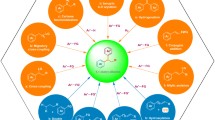Abstract
Transition metal catalysis constitutes a vital method for the construction of new C–C bonds on both a laboratory and industrial scale. In particular, palladium catalysis has established its position as one of the most powerful and reliable strategies in the syntheses of a broad spectrum of pharmaceuticals, agrochemicals, cosmetics etc. In order to develop this area of organometallic chemistry even further a full understanding of the involved mechanisms are of utmost importance.
You have full access to this open access chapter, Download chapter PDF
Similar content being viewed by others
Keywords
These keywords were added by machine and not by the authors. This process is experimental and the keywords may be updated as the learning algorithm improves.
Transition metal catalysis constitutes a vital method for the construction of new C–C bonds on both a laboratory and industrial scale. In particular, palladium catalysis has established its position as one of the most powerful and reliable strategies in the syntheses of a broad spectrum of pharmaceuticals, agrochemicals, cosmetics etc. In order to develop this area of organometallic chemistry even further a full understanding of the involved mechanisms are of utmost importance.
In this dissertation an in-depth investigation of the palladium 1,2-migration have been presented. Scope and limitations of the migratory process in the Heck reaction were investigated disclosing specific requirements and trends. The 1,2-migration was expanded to include the Negishi coupling reveling related characteristics suggesting parallel mechanisms. However, stoichiometric experiments implied two distinct pathways—a neutral and a cationic—depending on the catalytic system. In both cases an unprecedented alkenyl β-hydride elimination most likely seemed to be operative, thus expanding the applications of palladium catalysis.
Furthermore, processes relying on β-hydride eliminations were explored resulting in different variations of the Heck reaction. Aryl tosylates representing attractive alternatives to the corresponding triflates were successfully applied in the regioselective Heck reaction of electron rich olefins producing highly functionalized pyridines and pyrimidines relevant to the pharmaceutical industry. A nickel catalyzed Heck reaction was developed as a competitive and more sustainable alternative to the palladium catalyzed analogous. Experimental details and DFT calculations proposed a cationic nickel intermediate to be critical for successful reaction. Finally, a palladium catalyzed carbonylative Heck reaction using carbon monoxide generated ex situ relying on a newly patented two-chamber system were accomplished. The unique setup allowed for the effective incorporation of 13C labeled carbon monoxide introducing a novel strategy for the carbon isotope labeling of organic compounds.
Author information
Authors and Affiliations
Corresponding author
Rights and permissions
Copyright information
© 2012 Springer-Verlag Berlin Heidelberg
About this chapter
Cite this chapter
Gøgsig, T.M. (2012). Conclusions. In: New Discoveries on the β-Hydride Elimination. Springer Theses. Springer, Berlin, Heidelberg. https://doi.org/10.1007/978-3-642-32099-6_8
Download citation
DOI: https://doi.org/10.1007/978-3-642-32099-6_8
Published:
Publisher Name: Springer, Berlin, Heidelberg
Print ISBN: 978-3-642-32098-9
Online ISBN: 978-3-642-32099-6
eBook Packages: Chemistry and Materials ScienceChemistry and Material Science (R0)




